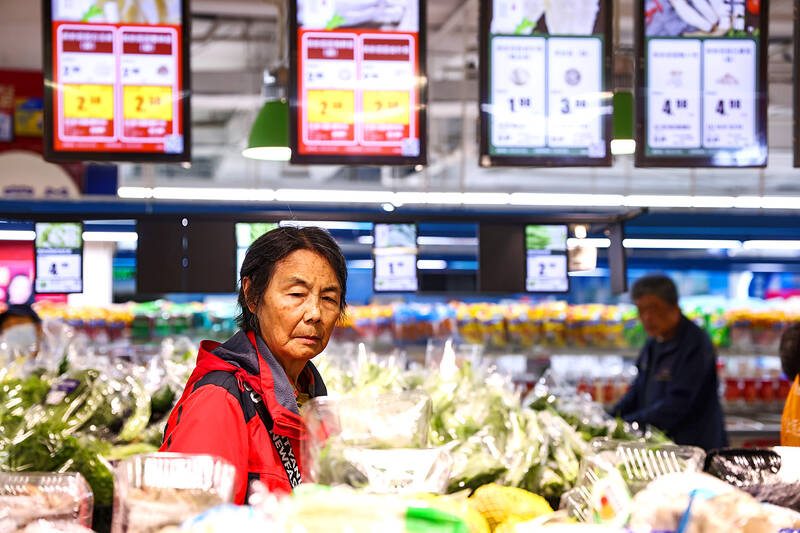China’s consumer deflation extended for a third month last month, as punitive tariffs imposed by the US add to a drag on prices from weak domestic demand.
The consumer price index fell 0.1 percent from a year earlier, the Chinese National Bureau of Statistics said on Saturday, similar to the drop in the previous month.
Factory deflation persisted for a 31st month, with the producer price index recording a decline of 2.7 percent compared with 2.5 percent in March.

Photo: EPA-EFE
Deflationary pressures are likely to linger and possibly get worse after US President Donald Trump took aim at most Chinese exports with a 145 percent tariff last month, provoking Beijing to retaliate in kind. The trade war could encourage some companies to offload their products at home, exacerbating already-fierce competition that might push firms to lower prices even further.
“Policy efforts to boost consumption since the fourth quarter of last year still appear to be failing to get much traction,” Bloomberg Economics economist David Qu (曲天石) wrote in a note on Saturday. “The key will be for the government to increase fiscal support quickly — especially if negotiations with the US fail to bring material relief on tariffs.”
Losses in jobs and incomes due to US tariffs might also weaken the ability and willingness of Chinese consumers to spend, likely prompting manufacturers and service providers to cut prices.
China’s economy continued to struggle from deflation in the first first three months of the year, reflecting an imbalance between supply and demand.
The GDP deflator — a broad measure of prices across the economy — declined for the eighth consecutive quarter, the longest streak since the quarterly data began in 1993.

JITTERS: Nexperia has a 20 percent market share for chips powering simpler features such as window controls, and changing supply chains could take years European carmakers are looking into ways to scratch components made with parts from China, spooked by deepening geopolitical spats playing out through chipmaker Nexperia BV and Beijing’s export controls on rare earths. To protect operations from trade ructions, several automakers are pushing major suppliers to find permanent alternatives to Chinese semiconductors, people familiar with the matter said. The industry is considering broader changes to its supply chain to adapt to shifting geopolitics, Europe’s main suppliers lobby CLEPA head Matthias Zink said. “We had some indications already — questions like: ‘How can you supply me without this dependency on China?’” Zink, who also

Taiwan Semiconductor Manufacturing Co (TSMC, 台積電) received about NT$147 billion (US$4.71 billion) in subsidies from the US, Japanese, German and Chinese governments over the past two years for its global expansion. Financial data compiled by the world’s largest contract chipmaker showed the company secured NT$4.77 billion in subsidies from the governments in the third quarter, bringing the total for the first three quarters of the year to about NT$71.9 billion. Along with the NT$75.16 billion in financial aid TSMC received last year, the chipmaker obtained NT$147 billion in subsidies in almost two years, the data showed. The subsidies received by its subsidiaries —

The number of Taiwanese working in the US rose to a record high of 137,000 last year, driven largely by Taiwan Semiconductor Manufacturing Co’s (TSMC, 台積電) rapid overseas expansion, according to government data released yesterday. A total of 666,000 Taiwanese nationals were employed abroad last year, an increase of 45,000 from 2023 and the highest level since the COVID-19 pandemic, data from the Directorate-General of Budget, Accounting and Statistics (DGBAS) showed. Overseas employment had steadily increased between 2009 and 2019, peaking at 739,000, before plunging to 319,000 in 2021 amid US-China trade tensions, global supply chain shifts, reshoring by Taiwanese companies and

At least US$50 million for the freedom of an Emirati sheikh: That is the king’s ransom paid two weeks ago to militants linked to al-Qaeda who are pushing to topple the Malian government and impose Islamic law. Alongside a crippling fuel blockade, the Group for the Support of Islam and Muslims (JNIM) has made kidnapping wealthy foreigners for a ransom a pillar of its strategy of “economic jihad.” Its goal: Oust the junta, which has struggled to contain Mali’s decade-long insurgency since taking power following back-to-back coups in 2020 and 2021, by scaring away investors and paralyzing the west African country’s economy.